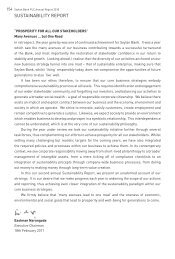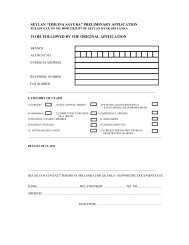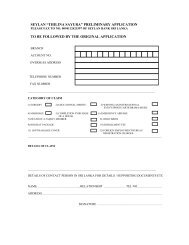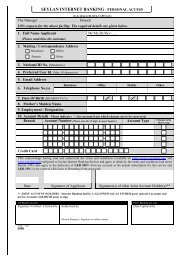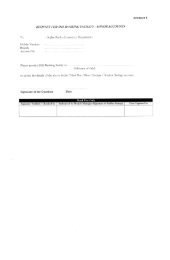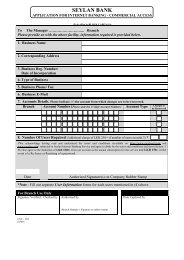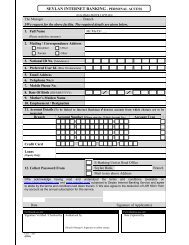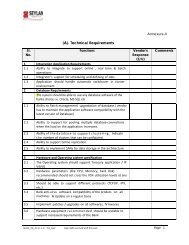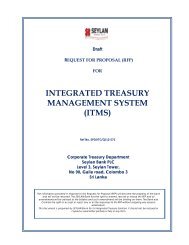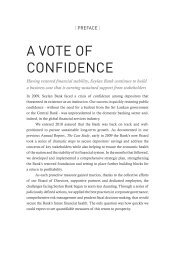The Case Study - Seylan Bank
The Case Study - Seylan Bank
The Case Study - Seylan Bank
Create successful ePaper yourself
Turn your PDF publications into a flip-book with our unique Google optimized e-Paper software.
66<strong>Seylan</strong> <strong>Bank</strong> PLC Annual Report 2009Risks arising from Financial InstrumentsInternational Financial Reporting Standards requirecertain disclosures on the risks arising fromvarious financial instruments. <strong>The</strong> <strong>Bank</strong> deals infinancial assets and liabilities and also in financialinstruments such as the fixed income securitiesmainly comprising of Government Securities viz.Treasury Bills and Treasury Bonds. <strong>The</strong> <strong>Bank</strong> helda trading portfolio of Treasury Bills and Bondsamounting to Rs. 14.37 Bn. as at 31st December 2009and an investment portfolio of Rs. 14.73 Bn. <strong>The</strong> mainrisk arising from the trading portfolio is the interestrate risk as detailed elsewhere in this Annual Report.<strong>Bank</strong> quantifies and monitors this risk on a regularbasis. Further, the instruments result in liquidity riskin a very insignificant manner as the instrumentsthemselves are fairly liquid and can be convertedinto cash quite easily or can be used as collateral toborrow in the REPO market.<strong>The</strong> <strong>Bank</strong> also deals in forward exchangecontracts mainly to cover the requirements of theclients and usually the positions are covered byopposite contracts and the level of exposure is notsignificant. <strong>The</strong> <strong>Bank</strong> also enters into currencyswaps in a minimal way.<strong>Bank</strong> does not as a policy usually enter intovarious derivative transactions on a speculative basis.Key risks and risk managementCredit RiskCredit Risk is the risk of default of capital and interestby the borrowers of the <strong>Bank</strong> as a result of which the<strong>Bank</strong> will encounter loss of revenue and a reductionin the value of its assets leading to reduced profits.<strong>The</strong> Board Credit subCommittee<strong>The</strong> Board Credit Subcommittee is chaired by theChairman of the <strong>Bank</strong> and has a minimum of twodirectors.<strong>The</strong> Board Credit Subcommittee formulatescredit policies for the <strong>Bank</strong> inclusive of maximumlimits of exposure to each major sector of the economy.<strong>The</strong> Committee formulates credit strategies towardsmaintaining a healthy credit portfolio and maintainscredit discipline within the <strong>Bank</strong>.<strong>The</strong> areas of focus include:• Approval of facilities within a range of specifiedlimits and recommendation of credit facilitiesbeyond such limits.• Formulating credit policies and guidelinesfor the <strong>Bank</strong> from time to time and review ofexisting policies.• Formulation of policies /review of existing policieson credit risk management.• Monitoring recoveries and formulating recoverystrategies.• Ensuring that the credit portfolio does not exceedaccepted levels of risk.• Review of single borrower limits and sector limitswhere more stringent limits are in place for anysector and also review of other lending criteria.<strong>The</strong> Board Credit Subcommittee meets ona regular basis at a frequency of at least twicea month. <strong>The</strong> Chief Executive Officer and KeyManagement Personnel in charge of credit areasare co-opted to the meetings.<strong>The</strong> Internal Credit CommitteeThis Committee comprises of Executive Managementand deals with approval of facilities within a certainrange of amounts. Further, this Committee deals withrecommendation of credit policies and implementationand monitoring of the same through respective creditdisbursement areas and branch outlets.Credit PoliciesThis Committee formulates and recommends<strong>Bank</strong>’s credit risk policies based on the board’srisk management strategy. It has also during theyear, improved the process for the management ofcredit and quantification of risk by standardisingreporting formats, following a more stringentpolicy towards collateral requirements for creditfacilities, restricting the exposures to any singlecustomer, scaling down the facilities where theclean exposure is excessive, and application ofshorter repayment periods on term loans.



